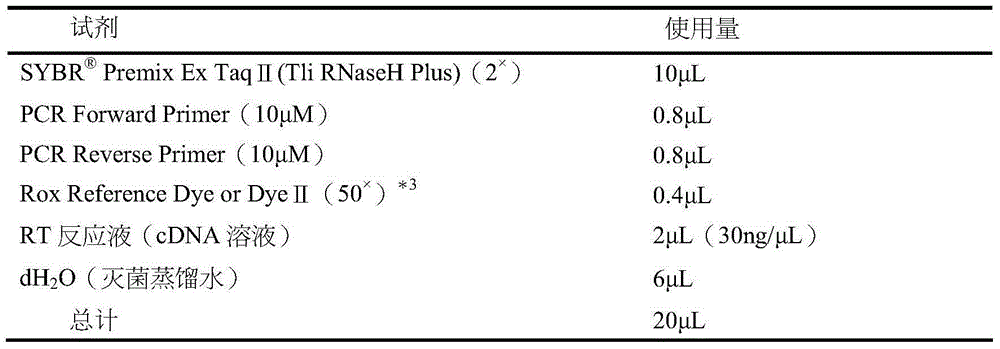Method for detecting potential pollution risk of aflatoxin in peanuts and products thereof by using real-time fluorescent quantitative PCR (polymerase chain reaction) technology
A real-time fluorescence quantitative and aflatoxin technology, which is applied in biochemical equipment and methods, and microbial measurement/inspection, etc., can solve the problems of inaccurate judgment standards and inability to make quantitative judgments, and achieve high sensitivity and safe and reliable detection results , good stability
- Summary
- Abstract
- Description
- Claims
- Application Information
AI Technical Summary
Problems solved by technology
Method used
Image
Examples
Embodiment
[0026] Example 1——The real-time fluorescent quantitative PCR technology is a method for detecting the risk of aflatoxin contamination in peanuts and its products with good specificity.
[0027] According to the AFLR gene sequence published by Genebank, the Primer Premier5.0 software was used to design specific primers, and its sequence was: upstream primer 5'-AACCTGATGACGACTGATAT-3', downstream primer 5'-AGCACCTTGAGAACGATAA-3', as can be seen from Figure 1 , using the designed primers to do Real-time PCR on Aspergillus flavus, there is no miscellaneous peak, and the product has good parallelism.
[0028] The specificity of Aspergillus flavus toxin-producing bacteria and Aspergillus flavus non-toxin-producing bacteria (without AFLR gene) was verified, and the results showed that the primers only amplified the strains containing the AFLR gene, but did not amplify the strains without the AFLR gene. There was amplification, which indicated that the primer had strong specificity an...
Embodiment 3
[0031] Example 3 - The method of real-time fluorescent quantitative PCR technology to detect the risk of aflatoxin contamination in peanuts and its products has good stability
[0032] Dilute the DNA of Aspergillus flavus toxin-producing bacteria to a concentration of 3×10-13 mg / ml, and repeat 6 times. The results are shown in Table 1. The coefficient of variation is 2.67%, indicating good repeatability.
[0033] Table 1 The repeatability test results of real-time quantitative PCR
[0034]
Embodiment 4
[0035] Example 4—Establishing a real-time fluorescent quantitative PCR relationship model between the risk of aflatoxin contamination in peanuts and the afIR gene of Aspergillus flavus
[0036] Correlation analysis was carried out between the aflatoxin content in peanut samples and the Ct value of Real-time PCR, and the correlation coefficient was -0.718, a significant negative correlation; the mathematical relationship equation was: y=-0.0852x+27.257.
[0037] Table 2 The content of aflatoxin in peanut and the Ct of fluorescent quantitative PCR
[0038]
[0039] Note: C is the aflatoxin content, and Ct is the number of cycles experienced when the fluorescent signal in each reaction tube reaches the set threshold.
PUM
 Login to View More
Login to View More Abstract
Description
Claims
Application Information
 Login to View More
Login to View More - R&D
- Intellectual Property
- Life Sciences
- Materials
- Tech Scout
- Unparalleled Data Quality
- Higher Quality Content
- 60% Fewer Hallucinations
Browse by: Latest US Patents, China's latest patents, Technical Efficacy Thesaurus, Application Domain, Technology Topic, Popular Technical Reports.
© 2025 PatSnap. All rights reserved.Legal|Privacy policy|Modern Slavery Act Transparency Statement|Sitemap|About US| Contact US: help@patsnap.com



